INSTITUT SUPERIEUR D'ANTHROPOLOGIE
INSTITUTE OF ANTHROPOLOGY
ONLINE COURSES / COURS A DISTANCE
FALL TERM : OCTOBER 2014
REGISTER NOW
CANADA - 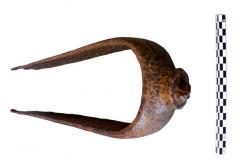
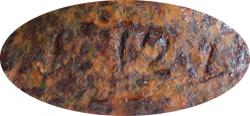 King William Island- A Government of Nunavut archaeology team claimed the first discovery from this year’s massive search for the remains of the 1845-46 Franklin Expedition to the Northwest Passage.Although the most extensive searches for remains are being undertaken at sea by a long list of public, private and non-profit agencies, the Nunavut archaeology team made the first finding of this year’s effort on land, on a small island southwest of King William Island, Sept. 1. The team found an “iron fitting from a Royal Navy ship, identified as part of a boat-launching davit” — or boat-lifting mechanism — “on an island in the southern search area,” the Government of Nunavut announced in a Sept. 8 news release. The group also found a wooden object, thought to serve as a plug for a “deck hawse” that held the ship’s chain cable. “These findings are important because the iron fitting is certainly from one of the Franklin shipwrecks,” the release states. “ This discovery is consistent with, and supports, 19th century Inuit oral testimony describing a shipwreck to the south of King William Island.” The iron artefact, measuring about 25 by 15 centimetres, bears “broad arrow” markings associated with the British Royal Navy of the early 19th century, according to the release.
King William Island- A Government of Nunavut archaeology team claimed the first discovery from this year’s massive search for the remains of the 1845-46 Franklin Expedition to the Northwest Passage.Although the most extensive searches for remains are being undertaken at sea by a long list of public, private and non-profit agencies, the Nunavut archaeology team made the first finding of this year’s effort on land, on a small island southwest of King William Island, Sept. 1. The team found an “iron fitting from a Royal Navy ship, identified as part of a boat-launching davit” — or boat-lifting mechanism — “on an island in the southern search area,” the Government of Nunavut announced in a Sept. 8 news release. The group also found a wooden object, thought to serve as a plug for a “deck hawse” that held the ship’s chain cable. “These findings are important because the iron fitting is certainly from one of the Franklin shipwrecks,” the release states. “ This discovery is consistent with, and supports, 19th century Inuit oral testimony describing a shipwreck to the south of King William Island.” The iron artefact, measuring about 25 by 15 centimetres, bears “broad arrow” markings associated with the British Royal Navy of the early 19th century, according to the release.
http://www.nunatsiaqonline.ca/stories/article/65674nunavut_archaeology_team_finds_franklin-era_ships_artefact/
BULGARIE – 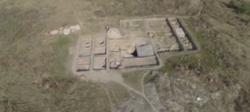 Pliska - Archaeologists working at the site of Pliska, once the capital of the First Bulgarian Kingdom, have uncovered a luxurious royal baths that they believe date back to the ninth century CE. The baths are probably the oldest medieval baths found in the country, reports on September 8 said. The design of the baths was heavily influence by Mediterranean culture. The bathroom was an architectural jewel of stone over an area of 80 square metres. Under a large dome-covered stone building, there were three separate but luxurious rooms. Archaeologist Pavel Georgiev told public broadcaster Bulgarian National Television that there was a separate dressing room, a room for bathing in lukewarm water, and next door a pool with a bathtub with warm or even hot water. This was adjacent to the furnace where the water was heated. Between the stone wall and the fine marble, there was a cavity through which hot air passed to keep the ceramic pipes warm. The report said that in the early ninth century, when elsewhere in Europe there were only wooden buildings, Pliska boasted huge stone buildings and baths with floor and wall heating. Georgiev said that this was notably important because the First Bulgarian Kingdom was a direct successor of a great ancient culture. The tradition was to build bathrooms separately, but very close to the living quarters. The archaeological team has discovered a part of this and the outline of one of the aristocratic mansions in the inner city of Pliska. Pliska, which boasts a large archaeological reserve and is the subject of ongoing digs, is best known as having been the capital of the First Bulgarian Kingdom from 681 to 893CE.
Pliska - Archaeologists working at the site of Pliska, once the capital of the First Bulgarian Kingdom, have uncovered a luxurious royal baths that they believe date back to the ninth century CE. The baths are probably the oldest medieval baths found in the country, reports on September 8 said. The design of the baths was heavily influence by Mediterranean culture. The bathroom was an architectural jewel of stone over an area of 80 square metres. Under a large dome-covered stone building, there were three separate but luxurious rooms. Archaeologist Pavel Georgiev told public broadcaster Bulgarian National Television that there was a separate dressing room, a room for bathing in lukewarm water, and next door a pool with a bathtub with warm or even hot water. This was adjacent to the furnace where the water was heated. Between the stone wall and the fine marble, there was a cavity through which hot air passed to keep the ceramic pipes warm. The report said that in the early ninth century, when elsewhere in Europe there were only wooden buildings, Pliska boasted huge stone buildings and baths with floor and wall heating. Georgiev said that this was notably important because the First Bulgarian Kingdom was a direct successor of a great ancient culture. The tradition was to build bathrooms separately, but very close to the living quarters. The archaeological team has discovered a part of this and the outline of one of the aristocratic mansions in the inner city of Pliska. Pliska, which boasts a large archaeological reserve and is the subject of ongoing digs, is best known as having been the capital of the First Bulgarian Kingdom from 681 to 893CE.
http://sofiaglobe.com/2014/09/09/archaeology-9th-century-baths-found-at-bulgarias-pliska/?utm_source=rss&utm_medium=rss&utm_campaign=archaeology-9th-century-baths-found-at-bulgarias-pliska
TURQUIE – 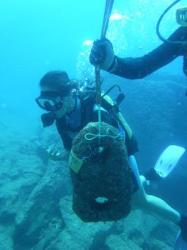 Egée - Underwater archaeological work in the Mediterranean has uncovered the remains of a port from the Bronze Age, along with 12 shipwrecks estimated to be 2,500 years old. The remains of these finds are being examined at Selçuk University’s Research Center, which is working to discover the underwater archaeological richness of the Mediterranean along with teams from Warsaw and Naples and the support of the Culture and Tourism Ministry. The Tabak (Plate) Wreckage Rescue Excavation, under the scientific consultancy of Harun Özdaş of Dokuz Eylül University and Hakan Öniz of Selçuk University, is the only independent underwater archaeological excavation on the Turkish coastline. The wreckage was found off the coast of Antalya and dates back to the Eastern Roman era, showing the extent of Byzantium plate export. The excavation has unearthed many plates, which can provide important detailed information about maritime commerce in the era. Researchers have also continued working on warships that sank off of the Çanakkale coast, and other sunken ships that hold importance for Çanakkale’s maritime history, in anticipation of the upcoming 100th anniversary of the naval portion of the Battle of Gallipoli. They are being aided by the Piri Reis Research Vessel.
Egée - Underwater archaeological work in the Mediterranean has uncovered the remains of a port from the Bronze Age, along with 12 shipwrecks estimated to be 2,500 years old. The remains of these finds are being examined at Selçuk University’s Research Center, which is working to discover the underwater archaeological richness of the Mediterranean along with teams from Warsaw and Naples and the support of the Culture and Tourism Ministry. The Tabak (Plate) Wreckage Rescue Excavation, under the scientific consultancy of Harun Özdaş of Dokuz Eylül University and Hakan Öniz of Selçuk University, is the only independent underwater archaeological excavation on the Turkish coastline. The wreckage was found off the coast of Antalya and dates back to the Eastern Roman era, showing the extent of Byzantium plate export. The excavation has unearthed many plates, which can provide important detailed information about maritime commerce in the era. Researchers have also continued working on warships that sank off of the Çanakkale coast, and other sunken ships that hold importance for Çanakkale’s maritime history, in anticipation of the upcoming 100th anniversary of the naval portion of the Battle of Gallipoli. They are being aided by the Piri Reis Research Vessel.
http://www.hurriyetdailynews.com/new-underwater-technology-explores-byzantine-past.aspx?PageID=238&NID=71441&NewsCatID=375
FRANCE – Najac - Il pourrait s'agir d'une patère romaine recouvrant un dépôt archéologique à incinération. Une découverte archéologique d'importance, qui n'a d'ailleurs pas manqué de susciter un bras de fer entre les organisateurs et la DRAC (direction régionale des affaires culturelles). Le site est actuellement sécurisé par Pierre Sesonds, propriétaire du terrain et le vestige est toujours enfoui. Michel Vaginay, conservateur général du patrimoine à la DRAC reste prudent sur la nature de la découverte, admettant toutefois la probalité d'une patère d'époque romaine. «Des discussions sont actuellement en cours pour organiser une fouille archéologique autour du vestige, courant septembre.» précisait-il.
http://www.ladepeche.fr/article/2014/09/08/1947169-un-tarnais-decouvre-un-vestige-de-2000-ans.html
FRANCE – 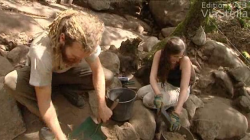 Cuciurpula- Les fouilles archéologiques de Cuciurpula, sur la commune de Serra di Scopamène,dans l'Alta Rocca, ont duré 3 semaines et s'achèveront dimanche. Cette année, sur ce site préhistorique qui compte 40 maisons datant du 12e au 6e avant Jésus-Christ, les archéologues en ont particulièrement fouillé deux. Cette année, deux d'entre elles ont été particulièrement examinées: tessons de céramique, bracelet en bronze etc
Cuciurpula- Les fouilles archéologiques de Cuciurpula, sur la commune de Serra di Scopamène,dans l'Alta Rocca, ont duré 3 semaines et s'achèveront dimanche. Cette année, sur ce site préhistorique qui compte 40 maisons datant du 12e au 6e avant Jésus-Christ, les archéologues en ont particulièrement fouillé deux. Cette année, deux d'entre elles ont été particulièrement examinées: tessons de céramique, bracelet en bronze etc
VIDEO =http://france3-regions.francetvinfo.fr/corse/2014/09/05/les-trouvailles-du-site-archeologique-de-cuciurpula-544478.html
ROYAUME UNI – 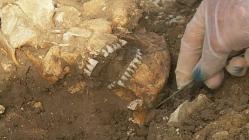 Peterborough - Developers building houses in Peterborough have unearthed a fascinating glimpse of the city's past. They've discovered a huge burial ground in Midland Road containing the skeletons of at least 70 people. It's thought the remains could be victims of the Black Death. For centuries they lay undisturbed while above them life went on for successive generations of Peterboreans. Now the skeletons laid to rest in this ancient burial ground have been unearthed giving us the chance to learn more about our medieval ancestors. The bones were found during an archaeological dig at this site where 90 new homes are being built. It's the biggest find of its type in the city. The bodies had been interred west to east in accordance with Christian burial practices.
Peterborough - Developers building houses in Peterborough have unearthed a fascinating glimpse of the city's past. They've discovered a huge burial ground in Midland Road containing the skeletons of at least 70 people. It's thought the remains could be victims of the Black Death. For centuries they lay undisturbed while above them life went on for successive generations of Peterboreans. Now the skeletons laid to rest in this ancient burial ground have been unearthed giving us the chance to learn more about our medieval ancestors. The bones were found during an archaeological dig at this site where 90 new homes are being built. It's the biggest find of its type in the city. The bodies had been interred west to east in accordance with Christian burial practices.
VIDEO : http://www.itv.com/news/anglia/2014-09-09/black-death-skeletons-unearthed-in-peterborough/?
BULGARIE –  Sozopol - An ancient coin believed to be the oldest one found so far in Bulgaria has been discovered in the Black Sea just off the town of Sozopol. According to Vladimir Penchev, numismatist at the National History Museum (NHM) in Sofia, the coin made of electrum (a gold/silver alloy) can be dated back to the second half of the 7th century BC as originating from the kingdom of Lydia which means it is at least 2,650 years old. Lydia was an ancient land of western Anatolia, extending east from the Aegean Sea and occupying the valleys of the Hermus and Cayster rivers. The Lydians were said to be the originators of gold and silver coins. The coin weighing 0,63 грама was equivalent to 1/24th of stater, an ancient Greek coin made of gold, silver or gold/silver alloy, the NHM said in a statement. It was discovered in sea water one meter deep off Sozopol by an unnamed scuba diver who turned it over to NHM.
Sozopol - An ancient coin believed to be the oldest one found so far in Bulgaria has been discovered in the Black Sea just off the town of Sozopol. According to Vladimir Penchev, numismatist at the National History Museum (NHM) in Sofia, the coin made of electrum (a gold/silver alloy) can be dated back to the second half of the 7th century BC as originating from the kingdom of Lydia which means it is at least 2,650 years old. Lydia was an ancient land of western Anatolia, extending east from the Aegean Sea and occupying the valleys of the Hermus and Cayster rivers. The Lydians were said to be the originators of gold and silver coins. The coin weighing 0,63 грама was equivalent to 1/24th of stater, an ancient Greek coin made of gold, silver or gold/silver alloy, the NHM said in a statement. It was discovered in sea water one meter deep off Sozopol by an unnamed scuba diver who turned it over to NHM.
http://www.novinite.com/articles/163252/Scuba+Diver+Finds+Oldest+Coin+in+Bulgaria?
ROYAUME UNI – 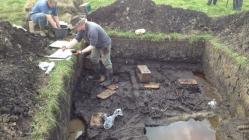
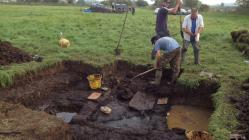 Glastonbury Lake Village - Archaeologists have been digging at the site of a 2,200 year old Iron Age settlement in Somerset. Glastonbury Lake Village is one if Britain's best preserved sites from the era. It was last excavated over a hundred years ago.
Glastonbury Lake Village - Archaeologists have been digging at the site of a 2,200 year old Iron Age settlement in Somerset. Glastonbury Lake Village is one if Britain's best preserved sites from the era. It was last excavated over a hundred years ago.
http://www.itv.com/news/west/update/2014-09-09/2-200-year-old-glastonbury-lake-village-is-excavated/?
AZERBAIDJAN – 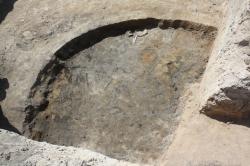 Alar - The archaeologists found more than 30 burial mounds and tombs dating back to II-I centuries BC in the village of Alar in the Yardimli region of Azerbaijan, which is located at an altitude of 2,000 meters above sea level, a senior researcher at the Institute of Archaeology and Ethnography of the Azerbaijani National Academy of Sciences (ANAS), PhD in history Anar Agalarzade told Trend Sept. 8. Agalarzade stressed that at present, an archaeological expedition continues excavations at the mounds in the Okyu and Arvana villages of the Yardimli region. "These mounds and gravestones were found by the archaeologists in the vicinity of the Peshtasar ridge of the Talysh Mountains," he added. Agalarzade also said that a vase, crockery, agate beads and other jewelry, as well as bronze items were also found by the archeologists here. The archaeologists suggest that these findings refer to the culture of the nomadic tribes of the late Bronze and early Iron Ages. He said that large-scale excavations are planned to be conducted in this area in the future.
Alar - The archaeologists found more than 30 burial mounds and tombs dating back to II-I centuries BC in the village of Alar in the Yardimli region of Azerbaijan, which is located at an altitude of 2,000 meters above sea level, a senior researcher at the Institute of Archaeology and Ethnography of the Azerbaijani National Academy of Sciences (ANAS), PhD in history Anar Agalarzade told Trend Sept. 8. Agalarzade stressed that at present, an archaeological expedition continues excavations at the mounds in the Okyu and Arvana villages of the Yardimli region. "These mounds and gravestones were found by the archaeologists in the vicinity of the Peshtasar ridge of the Talysh Mountains," he added. Agalarzade also said that a vase, crockery, agate beads and other jewelry, as well as bronze items were also found by the archeologists here. The archaeologists suggest that these findings refer to the culture of the nomadic tribes of the late Bronze and early Iron Ages. He said that large-scale excavations are planned to be conducted in this area in the future.
http://en.trend.az/azerbaijan/society/2309171.html
CHINE –  Gaoyou - A Chinese boy has made the discovery of a lifetime by stumbling across a 3,000-year-old bronze sword in a river in Jiangsu Province. Eleven-year-old Yang Junxi says he touched the rusty weapon's tip while washing his hands in the Laozhoulin River, in Gaoyou County, the state news agency Xinhua reports. After pulling it out he took it home, where it quickly became a sensation for curious locals, before the family decided to send it to officials for examination. "Some people even offered high prices to buy the sword," Junxi's father Jinhai says. "But I felt it would be illegal to sell the relic." Archaeologists have dated the 26cm (10in) weapon to either the Shang or Zhou dynasties - the dawn of Chinese civilisation - based on its material, size and shape. Lyu Zhiwei of the Gaoyou Cultural Relics Bureau says that while the sword appears to be of both decorative and practical use, its form suggests it was the status symbol of a civil official rather than a sword for fighting. The authorities are now planning a major archaeological dig in the river, once part of a system of ancient waterways that developed into today's Grand Canal. Junxi and his father have been given a reward for handing in the relic.
Gaoyou - A Chinese boy has made the discovery of a lifetime by stumbling across a 3,000-year-old bronze sword in a river in Jiangsu Province. Eleven-year-old Yang Junxi says he touched the rusty weapon's tip while washing his hands in the Laozhoulin River, in Gaoyou County, the state news agency Xinhua reports. After pulling it out he took it home, where it quickly became a sensation for curious locals, before the family decided to send it to officials for examination. "Some people even offered high prices to buy the sword," Junxi's father Jinhai says. "But I felt it would be illegal to sell the relic." Archaeologists have dated the 26cm (10in) weapon to either the Shang or Zhou dynasties - the dawn of Chinese civilisation - based on its material, size and shape. Lyu Zhiwei of the Gaoyou Cultural Relics Bureau says that while the sword appears to be of both decorative and practical use, its form suggests it was the status symbol of a civil official rather than a sword for fighting. The authorities are now planning a major archaeological dig in the river, once part of a system of ancient waterways that developed into today's Grand Canal. Junxi and his father have been given a reward for handing in the relic.
http://www.bbc.co.uk/news/blogs-news-from-elsewhere-29108764